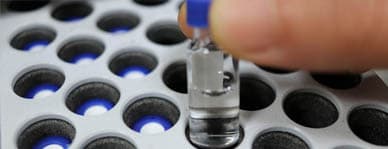
Alum bladder irrigation bag preparation is a challenge for many hospital pharmacies. Edge Pharma is excited to announce a solution that eliminates nonsterile to sterile compounding of this medication. Edge’s sterile concentrated alum solution will be available starting in January and comprises a 30g/300mL sterile aluminum potassium sulfate solution. Our alum solution is designed for sterile-to-sterile compounding, and only requires dilution to create a 30g/3000mL bladder irrigation bag. With many hospitals trying to eliminate nonsterile to sterile compounding, Edge’s sterile concentrated alum solution makes preparation substantially easier.
Sterile Concentrated Alum Solution Features
- Aluminum Potassium Sulfate 30g/300mL bag
- Concentrated for sterile-to-sterile compounding
- Dilute to create 30g/3000mL bladder irrigation bag
“Severe hemorrhagic cystitis often arises from anticancer chemotherapy or radiotherapy for pelvic malignancies. Infectious etiologies are less common causes except in immunocompromised hosts. These cases can be challenging problems for the urologist and a source of substantial morbidity and sometimes mortality for the patients.”(1)
Hemorrhagic cystitis is defined as diffuse bladder mucosal bleeding. When caused by radiation, hemorrhagic cystitis can appear as late as two decades after treatment. Patients with hemorrhagic cystitis generally present with the following symptoms: hematuria, anemia, urinary frequency, dysuria and incontinence secondary to blood clots obstructing the urethra. “As for all treatment pathways, beginning treatment with minimally invasive therapies is always recommended. As long as the patient is hemodynamically stable, clot removal and urinary drainage are the basis for initial treatment.”(2)
“Most of the time hematuria is controlled by continuous irrigation with 0.9 percent normal saline. This method may fail many a time and one may need to resort to transurethral fulguration of bleeding points. However, in selected cases there is a simple and safe method of continuous irrigation of the bladder with 1 percent alum solution without anesthesia, which may prevent the need for fulguration of the bleeding points or delay it for some time. Reports of toxicity due to systemic absorption of aluminum following alum irrigation are rare.”(3)
A study conducted at the Department of Urology, Mayo Clinic, identified 40 patients with hemorrhagic cystitis treated with intravesical alum. “All patients had failed continuous bladder irrigation with normal saline and clot evacuation. Treatment success was defined as requiring no additional therapy beyond normal saline irrigation after alum instillation.” The study found the alum use decreased patients’ transfusion requirement. Without alum, 82 percent of patients required a transfusion within 30 days, and with alum instillation, 59 percent of patients required a transfusion. The study concluded: “Intravesical alum therapy is well-tolerated, with resolution of hemorrhagic cystitis in approximately 60 percent of patients, and a durable response in approximately one-third. Given its favorable safety/efficacy profile, intravesical alum may be considered as a first-line treatment option for patients with hemorrhagic cystitis.”(4)
(1) Manikandan, R., Kumar, Santosh, Dorairajan, Lalgudi N., Indian Journal of Urologoy, online article, Hemorrhagic Cystitis: A Challenge to the Urologist,https://www.ncbi.nlm.nih.gov/
(2) Alesawa, Anwar M., El-Hakim, Assaad, Zorn, Kevin C., Saad, Fred, Current Opinion in Supportive and Palliative Care, online article, Radiation-Induced Hemorrhagic Cystitis, https://journals.lww.com/
(3) Barua, Sasanka Kumar, Das, Nabajeet, Barua, S.J. Rajeev, T.P. Bagchi, Pushal Kumar, Sarma, Debanga, Phukan, Mandeep, International Journal of Advances in Medicine, article, Management of Late Hemorrhagic Radiation in Patients of Carcinoma Cervix with Special Reference to 1 percent Alum Irrigation and Its Safety: A Clinical Study in a Tertiary Care Centre, International Journal of Advances in Medicine Barua SK et al. Int J Adv Med. 2019 Jun;6(3):599-604 http://www.ijmedicine.com
(4) Westerman, Mary E., Boorjiam, Stephen A., Linder, Brian J., Department of Urology, Mayo Clinic, Safety and Efficacy of Intravesical Alum for Intractable Hemorrhagic Cystitis: A Contemporary Evaluation https://www.ncbi.nlm.nih.gov/pmc/
References
1. Mary E. Westerman, Stephen A. Boorjian, Brian J. Linder. Department of Urology, Mayo Clinic, Rochester, Minnesota, USA. Safety and efficacy of intravesical alum for intractable hemorrhagic cystitis: a contemporary evaluation. (2016);42(6):1144 1149. https://www.ncbi.nlm.nih.gov/
“Intravesical alum therapy is well-tolerated, with resolution of HC in approximately 60% of patients, and a durable response in approximately one-third. Given its favorable safety/efficacy profile, intravesical alum may be considered as a first-line treatment option for patients with HC.”
2. The management of intractable haematuria. S.K.S. CHOONG, M. WALKDEN and R. K IRBY, St. George’s Hospital, Blackshaw Road, London, UK. BJU International (2000), 86, 951±959 http://urology.iupui.edu/
“There are various treatment options for intractable haematuria arising from several conditions applicable when more conservative measures have failed and before major surgery is contemplated or deemed unsuitable. The decision to use a particular treatment depends on the fitness of the patient and the anaesthetic requirement, the severity of the haematuria, the treatments available, the risks and severity of complications, and the prognosis of the condition. Intravesical formalin is effective in controlling intractable haematuria, but because it has potential serious complications it should be used with great caution and only after more conservative measures have failed.”
“In contrast, intravesical 1% alum irrigation for intractable haematuria can be used with no spinal or general anaesthesia or elaborate radiological procedures, is generally safe,effective and well tolerated, and is suitable as a first-line treatment.”
3. Hemorrhagic cystitis in cancer patients. Oct 07, 2019 Brian J Linder, MD, Nelson J Chao, MD, Mrinal M Gounder, MD. http://uptodate.com
“Alum — Given the efficacy and tolerable side effect profile of intravesical alum instillation, it is commonly the first intravesical therapy utilized when other more conservative measures have failed.”
Register To Order Online
We are currently licensed to sell to all US states except Alabama and Virginia. Please fill the form below to create an account. Medical, DEA, or hospital pharmacy licenses will be required to order sterile Alum Solution.
Create an account to order
Log-In if you have an account

